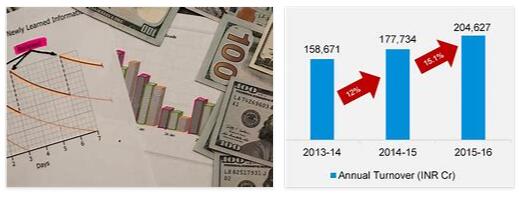The financial turnover is an indicator of the degree of liquidity of the assets of a company. It shows how quickly the company turns its market shares into revenue.
The index is represented by a percentage rate and formed by the ratio between sales and the free float, that is, the total number of freely traded shares.
Within an investment portfolio, the concept of turnover can also be used to indicate the renewal of the portfolio. It counts the volume of papers purchased by the investor divided by the average of the shareholders’ equity in the period.
The calculation of the financial turnover is done annually, and in the case of companies with greater liquidity, month by month. There are no ideal financial turnover rates, and comparisons must be made internally or in the same segment, in case these data are free in the market.
High financial turnover rates show that the company is selling more in less time, which is usually interesting from a capital standpoint. Experts indicate caution in the event of an unexpected high turnover, as it may be speculation action, as a maneuver to increase brokerage values.
How to calculate financial turnover?
A company’s financial turnover is calculated by the ratio of total sales or revenue in a given fiscal period to the total assets traded. In the case of shares, for example, these assets are determined by averaging the amount recorded at the end of the period compared to the beginning.
If the turnover to be calculated refers to the turnover of the investment portfolio, that is, on the side purchased from the securities, the ratio between what was purchased in that period and the average of the investor’s equity in the same is made.
Sometimes, an investor’s turnover rate reaches 100%, renewing his entire investment portfolio, depending on the situation of the market and / or companies. For example: an investor has a portfolio with 10 papers and in the same month the 10 companies in which he has a stake are down on the stock exchange. It is recommended by the broker to immediately sell all of them, to which the same investor will then choose to purchase shares of 10 other rising companies. Its turnover, ie the turnover of its investment portfolio, is 100%.
Who are the accounting users
Accounting users are groups of people who have an interest in assessing a company’s equity situation, whether internal or external.
The evaluation of accounting documents comes from the interest that people have in the activities of a company and the data presented with accounting.
Potential shareholders of a company, for example, use accounting data to find out whether it is worthwhile to acquire the shares of a particular company.
Internal and external accounting users
Accounting interest groups can be considered differently between internal and external users.
Internal users are those who are directly related to the company’s routine activity and use accounting data in their functions. We can consider:
- Administrators;
- Owners, shareholders or investors;
- Accountants and internal auditors;
- Other employees.
External users are those who are only interested in accounting data, without actively participating in the company’s processes. Some of them are:
- Government;
- Banks;
- Providers;
- Potential shareholders;
- Other stakeholders.
The interest in company data is varied, depending on who needs the information. The government, for example, uses not only to calculate the taxes due, but also has an interest in knowing how the country’s economy is doing, gathering data from all companies.
In the case of banks, it is possible that it is a loan, when the company is looking for third party capital to finance itself.
In all cases, accounting users are formed by interest groups around the company’s projects, affecting or being affected by the business. These groups are known as Stakeholders.
When is it worthwhile to make a private pension plan?
Making a private pension plan can be useful for those who do not have the discipline to save money and do not know how to keep track of their investments, since the insured person makes a commitment and the plan’s portfolio usually offers more attractive earnings than savings, for example.
However, those who remain well informed and follow the market closely could have a higher profitability if they chose to invest alone, since banks and insurance companies charge fees on private pension plans. In this case, making a private pension plan may not pay.
Another problem concerns the liquidity of the investment. The plan contract can allow the insured to withdraw the money invested in the short term if necessary. However, in addition to fees, for redemptions made with less than ten years, there is a greater income tax discount, which can reach 35%.
Attention to risks
Those who opt for a private pension plan also need to be aware that they have no guarantees if the institution that administers it faces financial problems and goes bankrupt. That is, if the bank or the insurer breaks down, the insured will enter the mass of creditors and it may take a long time to receive the money or even be at a loss.
For this reason, for those looking for security for the future, making a private pension does not dispense with the need for diversification of investments. Keeping savings in parallel, for emergencies, reduces the chance of needing to rescue private pensions ahead of time and, therefore, paying high fees.
In addition, the private pension plan cannot be seen as an alternative to Social Security. It is not a “private retirement” and should be thought of as a complement to the government’s retirement, since the amounts paid by the INSS can be considered insufficient to maintain the standard of living when you stop working.


